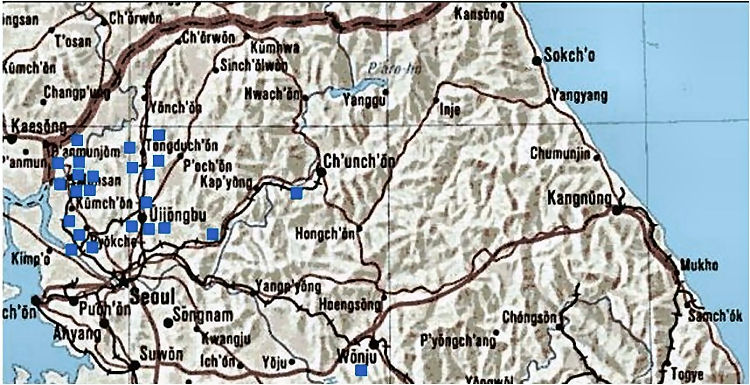The Foundation of Freedom is the Courage of Ordinary People History  On Line On Line
|

July 1, 2011: The Border. (The little blue squares are US Army Camps)
(The Horizontal line is the 38th parallel, the border at the start of the North Korean invasion.) |
During its first year, the war raged across entire Korea, from the southern tip at Pusan to the Yalu River. Desperate refugees were swept back and forth with it like flocks of birds in a forest fire. On July 1, 1951, almost two years of slaughter still lay ahead. But on that day, and the sixty years since, the border was about where the slaughter began, about where it would finally end.
| |
By July of 1951 we had finally driven the enemy back north of the 38th Parallel enough to establish a defensible border, and try to end the war by negotiation. As the Peace Talks dragged on, the war became largely exchanges of enormous volumes of artillery fire, equal to anything in WWI, with occasional savage fighting at a series of Outposts across Korea.
|

|
Korean winters in the open, as at the Chosin Reservoir, were brutal in the extreme. With the trench warfare of 1952-1953 the living conditions were vastly easier, but still required careful personal hygiene and dry clothing to survive without frost bite etc. |
But, though living conditions for troops in the line were tough, too cold in winter, too hot in summer, to lve at all one had to survive. The massive artillery barrages were the most serious concerns, once the fighting front had stabilized. Shown here are 17th Infantry Division trenches just after the Truce went into effect. July 28, 1953 |  |
 |
A soldier from the 180th Infantry mans a machine gun from inside a bunker. Our allies such as the British Commonwealth only started catching up to the comfort and security of our own pre-fab bunkers by late winter '52. As these are defensive positions, and the only real access for an anemy to breach it is with grenades from in front, they were positioned carefully to prevent frontal access, and there was a huge supply of grenades at hand for the defenders. Winter 1952-53. |
Company F, 9th Infantry, advances in central Korea. Artillery dominated offensive effor, but it was the bloody infantry that captured and held ground. Late 1952. |  |
 |
Collected shell casings. The enormous artillery barrages produced piles of salvageable casings. 1952 or 1953 |
A Marine pulls a chunk of shrapnel from his flak jacket. The CCF took the Vegas and Reno outputs from the 5th Marines on March 26, but the Marines re-took Vegas and held it against determined attacks until the CCF broke off the action. April 1953. |  |
 |
Battleship New Jersey blasts enemy positions near the 38th Parallel. Not only enemy infantry positions but their coastal cities were vulnerable to assault from the sea by huge 16 inch projectiles. 1952 or 1953. |
Our B29's were vulnerable to China's Soviet-supplied MiG's, but nonetheless caused extensive damage to North Korean cities under the protection of our Sabre fighters. 1952 or 1953 |  |
 |
Chongjin Industrial area after air-sea attacks. All industrial areas in North Korea were effectively put out of action during the Korean War. They relied almost entirely on China for all their manufactured needs. 1953. |
Flooded Bridge Crossing on Main Supply Route. The weather could make logistical movement difficult in Korea, but it was just as bad for the enemy, plus we had total control of the air. Spring 1953. |  |
 |
An air raid on the enemy's left flank in an attempt to reduce the effectiveness of their artillery. After the Cease Fire we found the Chinese had a very impressive underground defence system, tunneling through from the rear slope to effect observation posts on the forward slope. May 1953. |
An Aussie 'ambush patrol.' The bayonets indicate possible close quarter contact, and the field phone and cable shows that radio alone was not enough. The riflemen would carry a bandolier with ten 5-round .303 stripper clips, the bren gunners would have had 10 magazines, split between them and a rifleman who was No.2 if the Bren gunner was hit. Owen gunners normally carried 10 magazines, two on the weapon taped together, and 8 spread around in pockets. 36 mil. grenades, at least 2 to 4 per man, were hung from pockets or webbing belts. May 1953. |  |
 |
Defences in The Hook area were badly damaged by the bombardments of May 1953. Digging during the day was not possible so repairs were night operations, when a platoon or more of the Reserve Company would be marched forward to undertake digging and revetting work. There gradually took shape a well designed and constructed bunker systemn. By the time of the Truce a well constructed cut-and-cover trench system neared completion. Early July, 1953 |
The same section of trench system as in the above photo is shown a few weeks later after massive Chinese bombardments, as they vainly attempted to take The Hook before the Truce. The hellish artillery barrages during the static phases of the Korean War collapsed even well constructed trench networks to shallow gutters. As you will appreciate, defenders moving between forward defensive stong points on recon or combat patrols kept quite close to the ground. July 30, 1953. |  |
 |
US General Mark Clark Signs the Truce. After over two years of negotiation, posturing and frustrations, at the price of about half the total military casualties of the Korean War, an Armistice was signed, and the butchery stopped, at last. 27 July, 1953. |

7/27/53 - 2200 - After two years in the trenches ... The Shooting Stops
|

















